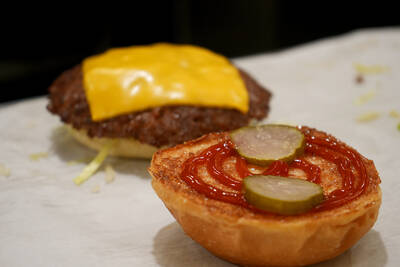Decorated with enough vintage posters and knick-knacks to stock a flea market, Ah-Tsai’s Restaurant (阿才的店) gets precariously close to theme restaurant territory. But a fiery, garlic-heavy menu of classic Taiwanese dishes proves the restaurant’s culinary chops.
Ah-Tsai’s is housed behind a picturesquely dilapidated-looking storefront on Jinshan South Road (金山南路), with overgrown planters and a vintage scooter parked out in front for good measure. The interior is carefully decorated to look untouched since the 1960s (a thick layer of dust on a row of Tatung electric fans and Bakelite telephones helps the overall effect). Scruffy white walls are festooned with colorful movie posters, yellowing calendars and black-and-white photographs of dreamy looking women in qipaos. Waiters grab dishware from cupboards topped with old tin toys and coin banks.
Every vintage item is probably twice as old as Ah-tsai’s clientele, which on weekdays appears to consist mostly of young professionals celebrating the end of a workday by knocking down bottles of Taiwan Beer. Ah-tsai’s strong flavors certainly seemed designed to induce thirstiness for a cold brew.
Take, for example, the stir-fried betel nut flowers (檳榔花, NT$100 or NT$200 depending on portion size), a white plant that resembles and tastes like a slightly sweeter version of bamboo. Ah-Tsai’s version tosses in a heap of cilantro, chili peppers and diced scallions, as well as a luxurious dose of garlic. After my taste buds got over the initial shock, I enjoyed the dish, even though all the spicy flavors threatened to compete with the mild taste of the crunchy betel nut flowers.
Also searingly hot was the kongpao shrimp (宮保蝦仁, NT$190 or NT$280), which was stir-fried with lots of chili peppers. Unlike kongpao chicken, this dish did not feature roasted peanuts, which were replaced with chunky slices of juicy zucchini. The vegetable was a welcome contrast to the shrimp, which had absorbed plenty of chili oil.
We didn’t get a respite from the spiciness with the Hakka stir-fry (客家小炒, NT$180 or NT$250), or strips of pork, bean curd and squid tossed with scallions, celery and yet more chili peppers. The stir-fry was good, but the meat and bean curd were slightly overcooked and tough.
Surprisingly, the shacha lamb stir-fry (沙茶羊肉, NT$130 to NT$200) tasted tame in comparison to the other dishes, probably because it was only lightly sprinkled with a few tiny bits of chili. The slices of meat were cooked with water spinach, basil and lots of shacha sauce, a thick condiment made of chopped fish and dried shrimp marinated in a mixture of soybean oil, garlic, chilis and shallots. The amount of lamb seemed skimpy but went very well with the basil and crunchy water spinach, whose hollow roots soaked up the shacha sauce.
At NT$380 or NT$480 depending on your order size, sanbeiji, or three cup chicken (三杯雞), is one of the priciest dishes on Ah-Tsai’s menu. It takes about 20 minutes to prepare, which gives the meat time to simmer slowly in a mixture of soy sauce, sesame oil and rice wine. Topped with cloves of garlic that had been cooked until tender, the chunks of chicken were heavy on bone and relatively short on meat, but nonetheless delicious and worth the wait.

Taiwan can often feel woefully behind on global trends, from fashion to food, and influences can sometimes feel like the last on the metaphorical bandwagon. In the West, suddenly every burger is being smashed and honey has become “hot” and we’re all drinking orange wine. But it took a good while for a smash burger in Taipei to come across my radar. For the uninitiated, a smash burger is, well, a normal burger patty but smashed flat. Originally, I didn’t understand. Surely the best part of a burger is the thick patty with all the juiciness of the beef, the

This year’s Miss Universe in Thailand has been marred by ugly drama, with allegations of an insult to a beauty queen’s intellect, a walkout by pageant contestants and a tearful tantrum by the host. More than 120 women from across the world have gathered in Thailand, vying to be crowned Miss Universe in a contest considered one of the “big four” of global beauty pageants. But the runup has been dominated by the off-stage antics of the coiffed contestants and their Thai hosts, escalating into a feminist firestorm drawing the attention of Mexico’s president. On Tuesday, Mexican delegate Fatima Bosch staged a

The ultimate goal of the Chinese Communist Party (CCP) is the total and overwhelming domination of everything within the sphere of what it considers China and deems as theirs. All decision-making by the CCP must be understood through that lens. Any decision made is to entrench — or ideally expand that power. They are fiercely hostile to anything that weakens or compromises their control of “China.” By design, they will stop at nothing to ensure that there is no distinction between the CCP and the Chinese nation, people, culture, civilization, religion, economy, property, military or government — they are all subsidiary

Would you eat lab-grown chocolate? I requested a sample from California Cultured, a Sacramento-based company. Its chocolate, not yet commercially available, is made with techniques that have previously been used to synthesize other bioactive products like certain plant-derived pharmaceuticals for commercial sale. A few days later, it arrives. The morsel, barely bigger than a coffee bean, is supposed to be the flavor equivalent of a 70 percent to 80 percent dark chocolate. I tear open its sealed packet and a chocolatey aroma escapes — so far, so good. I pop it in my mouth. Slightly waxy and distinctly bitter, it boasts those bright,